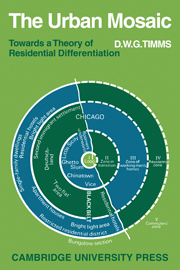Book contents
5 - The spatial patterning of residential differentiation
Published online by Cambridge University Press: 05 January 2012
Summary
The residential differentiation of the urban population, a function of the axes of social differentiation extant in the society concerned, is reflected in a sifting and sorting of populations and locations. As the city develops typical patterns of differentiation become apparent. Different areas become associated with particular types of population and certain systematic relationships between geographical space and social space appear. The concern of the present chapter is with the spatial aspects of residential differentiation and, more particularly, with the validity of certain general models of this spatial structure which have appeared in the literature.
Discussions of the spatial aspects of urban structure generally concern themselves with three general models of urban form: the zonal, the sectoral, and the multiple nuclei. In the present case only the two former approaches will be examined. In contrast to the multiple nuclei model both the zonal and the sectoral analogies are concerned with the structural connotations of a particular set of differentiating processes, predict particular patterns of residential differentiation, and lend themselves readily to empirical test. The multiple nuclei ‘theory’ may be regarded as a caveat to the more general zonal and sectoral models.
THE ZONAL MODEL OF URBAN GROWTH AND STRUCTURE
The concern of the early Chicago ecologists with the differences in environment and in behaviour between different parts of the city led not only to descriptive studies of the ways of life to be found in particular natural areas, but also to a concern with the general features of urban structure.
- Type
- Chapter
- Information
- The Urban MosaicTowards a Theory of Residential Differentiation, pp. 211 - 249Publisher: Cambridge University PressPrint publication year: 1971



